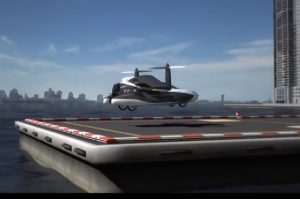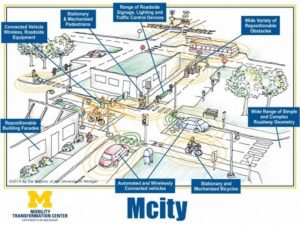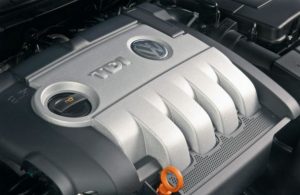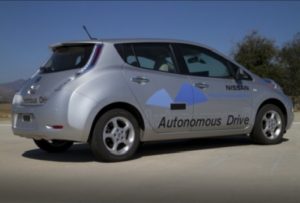 If you’re a fan of science fiction author Philip K. Dick, and movies made from his writings, you’ve probably been thinking about flying cars for years. Featured in the Do Androids Dream of Electric Sheep? novel and Blade Runner film – and “The Electric Ant” and “Minority Report” short stories (along with the Steven Spielberg film Minority Report) – flying cars will be one of the mobility options we use daily, according to the author.
If you’re a fan of science fiction author Philip K. Dick, and movies made from his writings, you’ve probably been thinking about flying cars for years. Featured in the Do Androids Dream of Electric Sheep? novel and Blade Runner film – and “The Electric Ant” and “Minority Report” short stories (along with the Steven Spielberg film Minority Report) – flying cars will be one of the mobility options we use daily, according to the author.
Flying cars, and similar technologies such as aerial delivery drones, are on a similar track as autonomous vehicles. They’re still in the early testing and development phase, but it looks like we will see them on our roads and skyways much sooner than expected. Google co-founder Larry Page seems to think so.
Page, CEO of Google’s parent company, Alphabet Inc., is spending his own money on two startups developing flying cars. He’s funded one of them, Zee.Aero, more than $100 million since it started in 2010. Since last year, Page has also been backing another startup, Kitty Hawk, which is making another flying car that could compete with Zee.Aero.
Zee.Aero conducts test flights of its prototype at an airport hangar in Hollister, Calif. The startup firm also has a manufacturing facility on NASA’s research center at the edge of Mountain View, Calif. Zee.Aero employees call Page the guy upstairs (‘GUS’). Page had demanded his involvement in the startup should stay hidden, according to an article last week in Bloomberg.
Kitty Hawk has headquarters about half a mile away from Zee.Aero, The startup is working on “something that resembles a giant version of a quadcopter drone,” according to Bloomberg.
Larry Page isn’t the only investor passionate about flying cars……..
Terrafugia TF-X received Federal Aviation Administration approval for test flights in late 2015. The hybrid-electric flying car will have fold out wings with twin electric motor pods attached to it, and is capable of recharging its batteries either from its engine or by plugging in to electric car charging stations. This mid-size car has twin helicopter-style rotors at the tips of its wings that fold out of the car and lift the TF-X into the sky. Once it’s up in the air, electric engines teamed with a 300-horsepower engine provide power. The rotors fold back, and a ducted fan pushes the TF-X along. It has a cruising speed of about 200 mph, with a range of about 500 miles.
The company says that development of the TF-X hybrid-electric flying car is expected to last 8-12 years. Once developed it will be tested in a wind tunnel at Massachusetts Institute of Technology. It could go on sale for $120,000 and seat four people. You can watch the video here; and the image was taken from the video for the photo shown at the beginning of this article.
Google is working with NASA and 13 other companies, including Amazon and Verizon, to create an air-traffic control system for drones, called Unmanned Aerial System (UAS) Traffic Management. With safety being a key concern, the federal government is seeking to work with the private sector to create rules of the aerial highways. Recent crashes of drones, including at national parks and on the White House grounds, have brought concern to watching over the new technologies being tested. The economic opportunities are part of gaining support from corporate backers.
“They definitely see it as an economic opportunity and as something that they want to participate in,” said Brian Wynne, president of the Association for Unmanned Vehicle Systems International. “This is real magic.”
NASA is researching prototype technologies for a UAS Traffic Management (UTM) system that could develop airspace integration requirements for enabling safe, efficient low-altitude operations. Currently, there is no established infrastructure to enable and safely manage the widespread use of low-altitude airspace and UAS operations. A UTM system for low-altitude airspace may be needed, perhaps leveraging concepts from the system of roads, lanes, stop signs, rules, and lights that govern vehicles on the ground today, whether the vehicles are driven by humans or are automated, NASA says.
Amazon has gained a lot of attention with its Prime Air automated delivery drones. In December, Amazon released a video showing a prototype of one of its delivery drones, which shares features of both helicopters and airplanes. Prime Air will get packages to customers within 30 minutes of them ordering it online at Amazon.com, according to Amazon’s Paul Misener. The range has to be over 10 miles and the carried weight will be less than five pounds for typical Amazon orders and up to 55 pounds, he said.
During a presentation at ACT Expo 2016, Steve Burns, CEO of Workhorse Group Inc., talked about the company’s truck-based HorseFly Unmanned Aerial Vehicle (UAV) delivery system, which is currently undergoing testing by Workhorse under a Section 333 exception granted by the Federal Aviation Administration. At its booth, the company showed a video featuring a small drone launching from the top of a delivery truck, flying a package to a nearby house and returning to the vehicle. Burns focused on the economic efficiencies and state-of-the-art technology in the HorseFly during his presentation.
A Chinese company’s EHang 184 has been cleared for testing in Nevada. The approval was given by the Nevada governor’s office to develop and test the vehicle at the state’s Federal Aviation Administration-approved drone test site. The electric passenger drone created by EHang was unveiled at CES in Las Vegas in January. The company says that it’s the world’s first passenger drone and is capable of autonomously carrying a person in the air for 23 minutes. It’s a 142-horsepower “personal flying vehicle” that can transport a single person at an altitude of more than 11,000 feet, China’s People’s Daily Online reported.
Other flying car projects in development described in a lengthy Bloomberg feature include:
- Volocopter made by E-volo with a price tag of $280,000 and seating for two. The prototype all-electric vehicle will be sold as a hybrid to increase flight times. It will have 18 propellers in a circular structure placed above the cockpit.
- AeroMobil 3.0 will cost $400,000 and seat four. It will be gasoline powered, can take off from driving down a road and soaring to the air quickly, and can cover a flight distance from, say, New York to Toronto. The company, AeroMobil, says it will start taking orders for it this year.
- Moller Skycar is being built at Moller’s workshop in Davis, Calif. Moller International says it will cost $500,000 to $1 million and will seat four. It will have a range of 805 miles at 131 mpg, and a maximum speed of 308 mph. Founder Paul Moller has been trying to build a flying car for about 50 years; this is the fifth-generation flying car Moller has built. Investors have put in more than $100 million in his test projects over the years.
- Lilium Jet, from German startup Lilium Aviation, is the world’s first all-electric vertical takeoff and landing (VTOL) plane, according to the company. The price has yet to be determined and will seat two people. It has a range of 300 miles and a maximum speed of 250 mpg. The company says it will be easy to fly with software doing much of the work. Lilium Aviation has received funding form the European Union.
- Joby Aviation says that customers will be able to call over its Joby flying car similar to getting an Uber ride. The all-electric plane, which seats two, will have a 100-to-200 mile range after being charged. The company expects to begin flying prototypes by this year’s end. It’s being built at a 500-acre compound in Santa Cruz, Calif. Future flying cars will seat four and look more like airplanes with six propellers positioned around the aircraft.

 If you work in the auto industry, staying informed can be all-consuming these days – with the Takata airbag recall, the Volkswagen diesel car scandal, automakers striving to become the first one selling self-driving cars, and the impact low fuel prices is having on green car sales. There is one topic I would advise you to stay current on, as it touches upon all the rest – connected car technologies.
If you work in the auto industry, staying informed can be all-consuming these days – with the Takata airbag recall, the Volkswagen diesel car scandal, automakers striving to become the first one selling self-driving cars, and the impact low fuel prices is having on green car sales. There is one topic I would advise you to stay current on, as it touches upon all the rest – connected car technologies. More on the Volkswagen diesel emissions scandal……… Frank Tuch, previously head of VW’s group quality control,
More on the Volkswagen diesel emissions scandal……… Frank Tuch, previously head of VW’s group quality control,  General Motors Co. is betting big on its future in the fast-changing automotive space. Along with its investments in Lyft, Sidecar, and its Maven startup brand, GM has announced management changes to support its next-generation vehicle technologies. Doug Parks, GM’s vice president for global product programs, is now vice president for autonomous technology and vehicle execution. Parks will oversee projects to develop new electrical and battery systems and software for autonomous and electric vehicles, the company said. There are other executives taking positions in GM’s new Autonomous and Technology Vehicle Development Team with similar backgrounds in electric vehicles and technology innovations.
General Motors Co. is betting big on its future in the fast-changing automotive space. Along with its investments in Lyft, Sidecar, and its Maven startup brand, GM has announced management changes to support its next-generation vehicle technologies. Doug Parks, GM’s vice president for global product programs, is now vice president for autonomous technology and vehicle execution. Parks will oversee projects to develop new electrical and battery systems and software for autonomous and electric vehicles, the company said. There are other executives taking positions in GM’s new Autonomous and Technology Vehicle Development Team with similar backgrounds in electric vehicles and technology innovations.